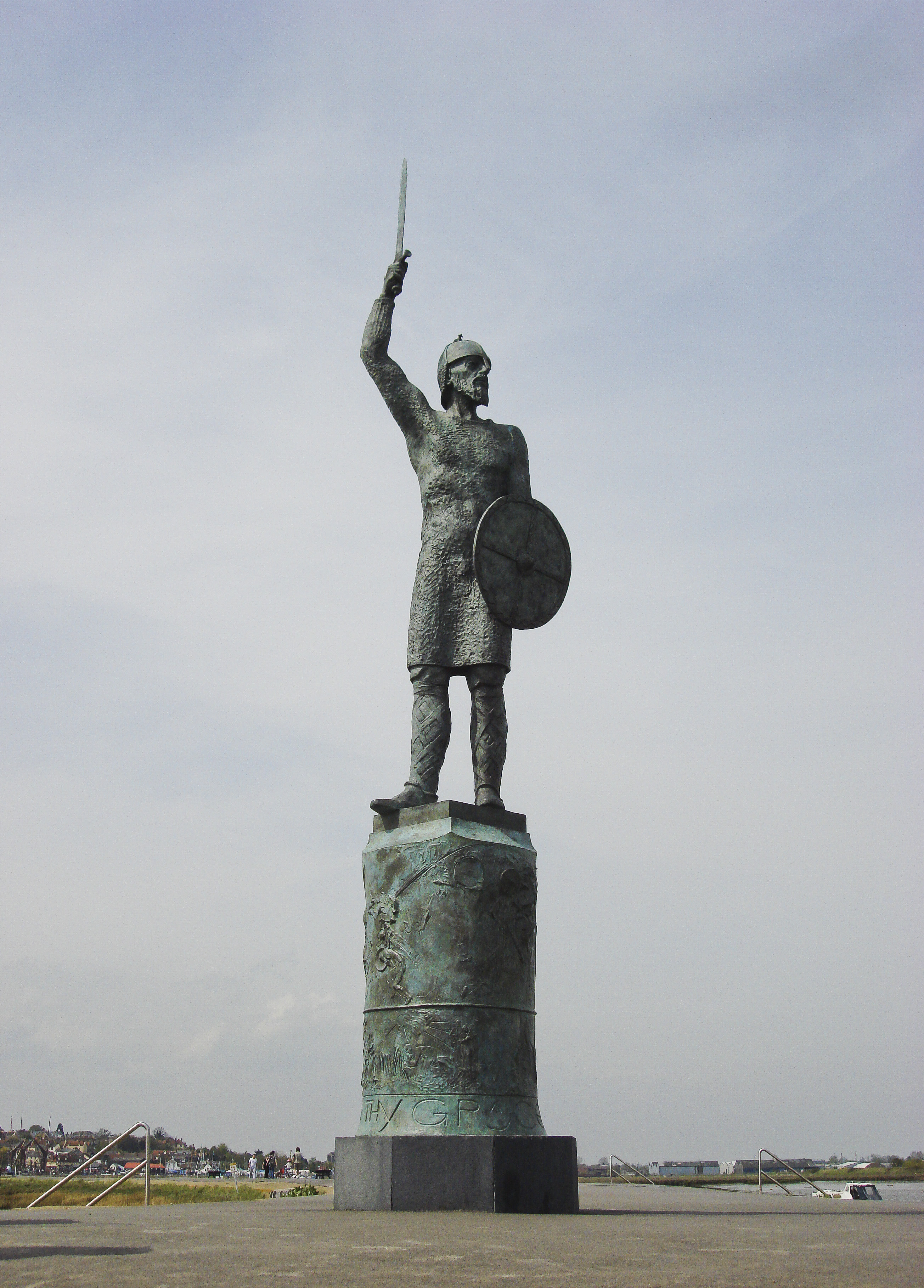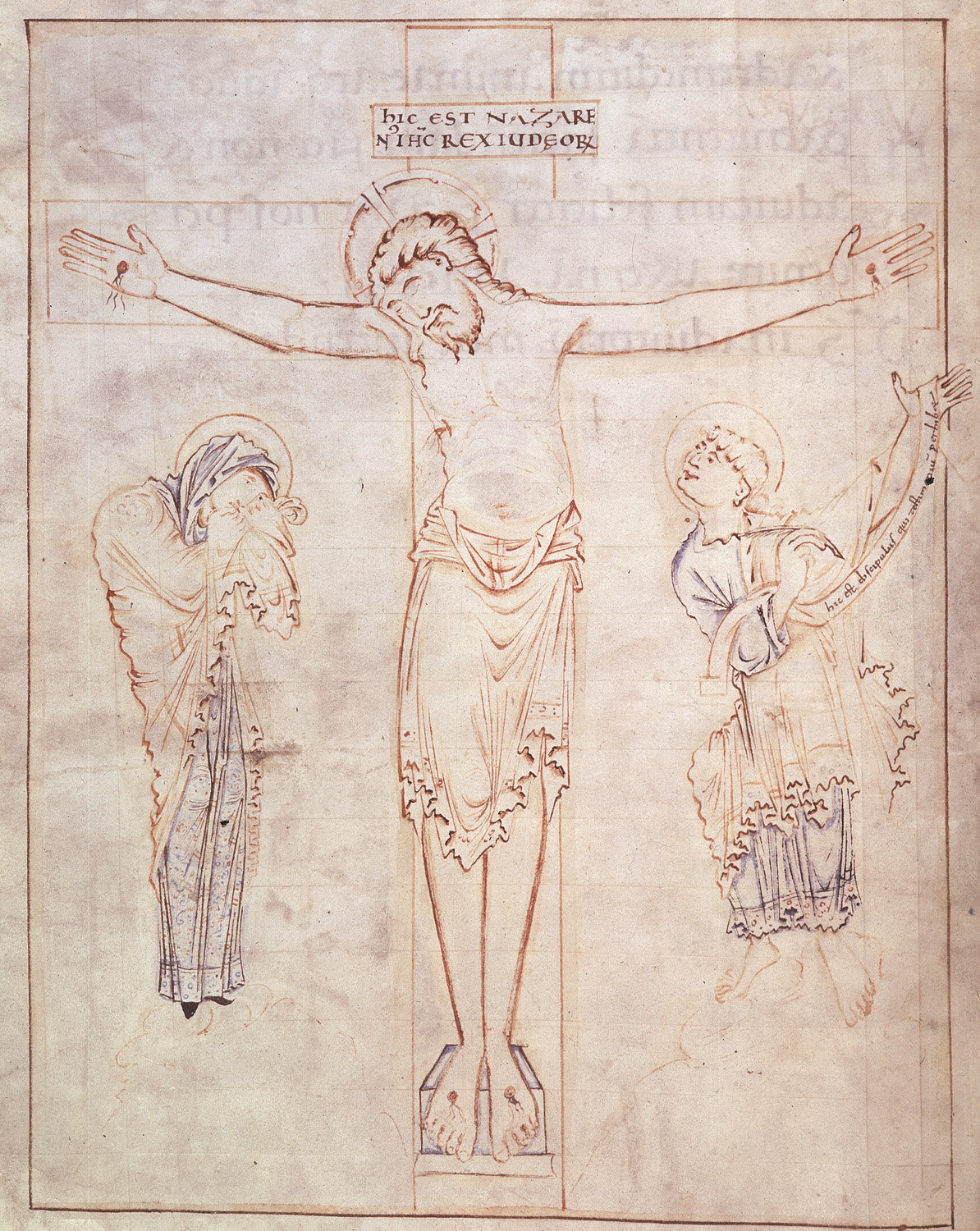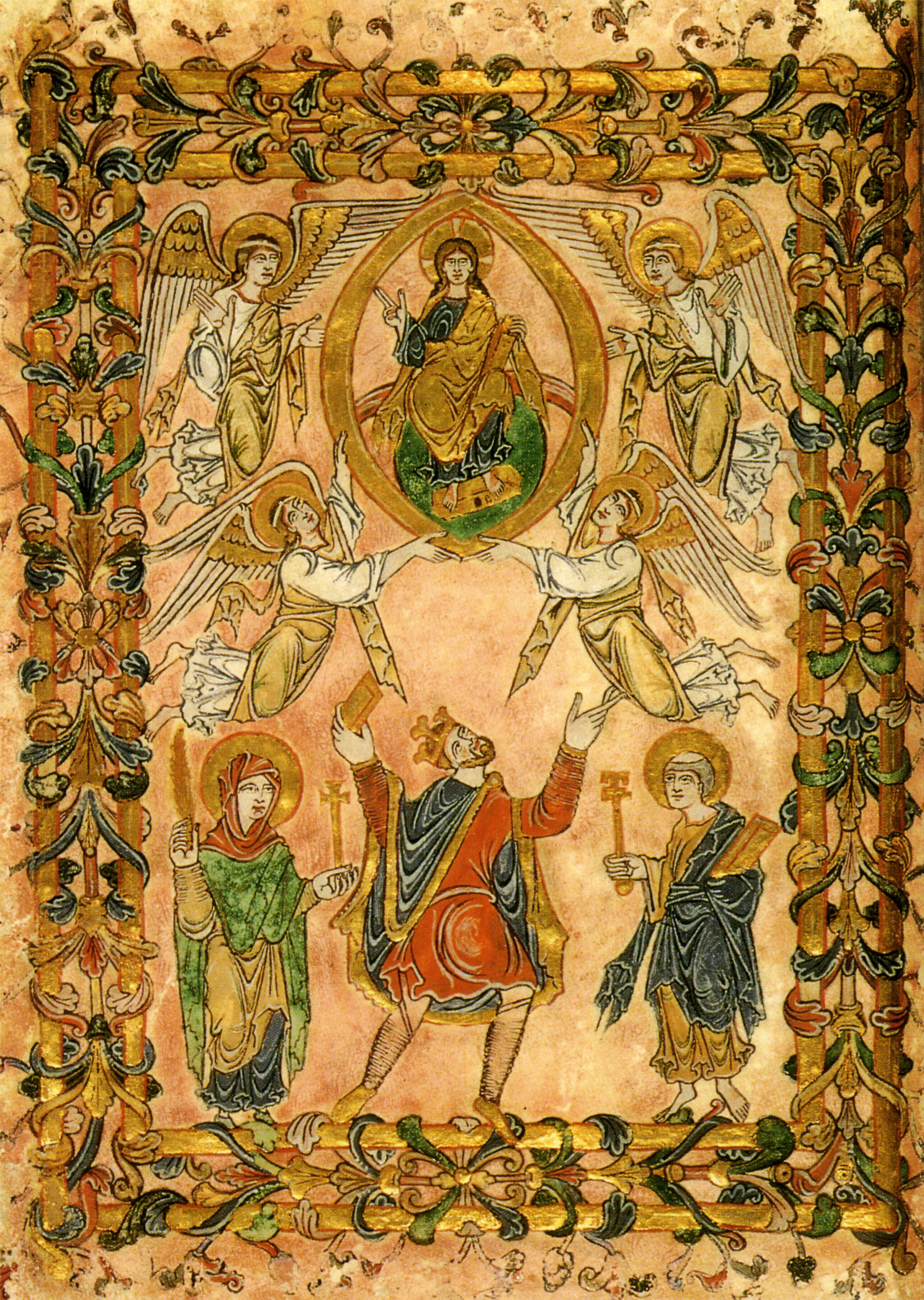|
Г†thelstan Half-King
Æthelstan Half-King (fl. 932 – 956) was an important and influential Ealdorman of East Anglia who interacted with five kings of England, including his adopted son King Edgar the Peaceful. Many of Æthelstan's close relatives were also involved in important affairs, but soon after the death of King Eadred in 955, he left his position and became a monk at Glastonbury Abbey. Origins Æthelstan was the son of Æthelfrith, an Ealdorman who held lands in Somerset, Berkshire, and Middlesex. His mother was Æthelgyth, daughter of Æthelwulf. His elder brother Ælfstan and his younger brothers Æthelwold and Ædric or Eadric, were Ealdormen of south and east Mercia, Kent and central Wessex, respectively.Hart, 2004 Æthelfrith was an ealdorman in Mercia in the late ninth and early tenth centuries. Career Æthelstan seems to have been appointed Ealdorman of East Anglia and other parts by King Æthelstan in about 932. The lands King Æthelstan gave him had mostly been part of the Danelaw w ... [...More Info...] [...Related Items...] OR: [Wikipedia] [Google] [Baidu] |
Ealdorman
Ealdorman (, ) was a term in Anglo-Saxon England which originally applied to a man of high status, including some of royal birth, whose authority was independent of the king. It evolved in meaning and in the eighth century was sometimes applied to the former kings of territories which had submitted to great powers such as Mercia. In Wessex in the second half of the ninth century it meant the leaders of individual shires appointed by the king. By the tenth century ealdormen had become the local representatives of the West Saxon king of England. Ealdormen would lead in battle, preside over courts and levy taxation. Ealdormanries were the most prestigious royal appointments, the possession of noble families and semi-independent rulers. Their territories became large, often covering former kingdoms such as Mercia or East Anglia. Southern ealdormen often attended court, reflecting increasing centralisation of the kingdom, but the loyalty of northern ealdormen was more uncertain. In ... [...More Info...] [...Related Items...] OR: [Wikipedia] [Google] [Baidu] |
Bedfordshire
Bedfordshire (; abbreviated Beds) is a ceremonial county in the East of England. The county has been administered by three unitary authorities, Borough of Bedford, Central Bedfordshire and Borough of Luton, since Bedfordshire County Council was abolished in 2009. Bedfordshire is bordered by Cambridgeshire to the east and north-east, Northamptonshire to the north, Buckinghamshire to the west and Hertfordshire to the south-east and south. It is the fourteenth most densely populated county of England, with over half the population of the county living in the two largest built-up areas: Luton (258,018) and Bedford (106,940). The highest elevation point is on Dunstable Downs in the Chilterns. History The first recorded use of the name in 1011 was "Bedanfordscir," meaning the shire or county of Bedford, which itself means "Beda's ford" (river crossing). Bedfordshire was historically divided into nine hundreds: Barford, Biggleswade, Clifton, Flitt, Manshead, Redbornestoke, S ... [...More Info...] [...Related Items...] OR: [Wikipedia] [Google] [Baidu] |
Battle Of Maldon
The Battle of Maldon took place on 11 August 991 AD near Maldon beside the River Blackwater in Essex, England, during the reign of Г†thelred the Unready. Earl Byrhtnoth and his thegns led the English against a Viking invasion. The battle ended in an Anglo-Saxon defeat. After the battle Archbishop Sigeric of Canterbury and the aldermen of the south-western provinces advised King Г†thelred to buy off the Vikings rather than continue the armed struggle. The result was a payment of Danegeld of 10,000 Roman pounds (3,300 kg) of silver (approx ВЈ1.8M at 2022 prices). An account of the battle, embellished with many speeches attributed to the warriors and with other details, is related in an Old English poem which is usually named ''The Battle of Maldon''. A modern embroidery created for the millennium celebration in 1991 and, in part, depicting the battle, can be seen at the Maeldune Centre in Maldon. One manuscript of the ''Anglo-Saxon Chronicle'' states that a certain O ... [...More Info...] [...Related Items...] OR: [Wikipedia] [Google] [Baidu] |
Byrhtnoth
Byrhtnoth ( ang, ByrhtnoГ°), Ealdorman of Essex ( 931 - 11 August 991), died at the Battle of Maldon. His name is composed of the Old English ''beorht'' (bright) and ''noГѕ'' (courage). He is the subject of ''The Battle of Maldon'', an Old English poem, J.R.R. Tolkien's short play in verse, '' The Homecoming of Beorhtnoth, Beorhthelm's Son'', and a modern statue at Maldon. Death in battle His death, while leading the Anglo-Saxon forces against the Vikings in 991, is the subject of the famous Old English poem ''The Battle of Maldon''. As presented there, his decision to allow the Vikings to move to a better position was heroic but fatal. He was said to stand well over six feet in height, and was around the age of sixty years at the Battle of Maldon, with "swan-white hair". Although it is believed that he fell early in the battle, some say that it took three men to kill him, one of them almost severing Byrhtnoth's arm in the process. He had previously had several military succe ... [...More Info...] [...Related Items...] OR: [Wikipedia] [Google] [Baidu] |
Г†lfhere, Ealdorman Of Mercia
Г†lfhere (died in 983) was Ealdorman of Mercia. His family, along with those of Г†thelstan Half-King and Г†thelstan Rota, rose to greatness in the middle third of the 10th century. In the reign of Edward the Martyr, Г†lfhere was a leader of the anti-monastic reaction and an ally of Edward's stepmother Queen Dowager Г†lfthryth. After the killing of Edward by Г†lfthryth's servants in 978, Г†lfhere supported the new king, Г†lfthryth's son Г†thelred the Unready, and was the leading nobleman in the Kingdom of England until his death in 983. Origins and relations Г†lfhere was a son of Ealhhelm (fl. 940–951) who had been one of the several ealdormen in Mercia in the reigns of Kings Edmund and Eadred. The family was of Wessex origin, like most of those prominent in Mercia in the period, and may have been connected to the royal family, probably members of a collateral branch of the Royal house. The family's power-base was probably in south-west Mercia, in the diocese of Worcester, t ... [...More Info...] [...Related Items...] OR: [Wikipedia] [Google] [Baidu] |
Godwin, Earl Of Wessex
Godwin of Wessex ( ang, Godwine; – 15 April 1053) was an English nobleman who became one of the most powerful earls in Kingdom of England, England under the Denmark, Danish king Cnut the Great (King of England from 1016 to 1035) and his successors. Cnut made Godwin the first Earl of Wessex (). Godwin was the father of King Harold Godwinson, Harold II () and of Edith of Wessex, who in 1045 married King Edward the Confessor (). Rise to power Godwin was born , likely in Sussex. Godwin's father was probably Wulfnoth Cild, who was a thegn of Kingdom of Sussex, Sussex. His origin is unknown but 'Child' (also written Cild) is cognate with 'the Younger' or 'Junior' and as today associated with some form of inheritance. In 1009 Wulfnoth was accused of unknown crimes at a muster of Æthelred the Unready's fleet and fled with twenty ships; the ships sent to pursue him were destroyed in a storm. Godwin was probably an adherent of Æthelred's eldest son, Æthelstan Ætheling, Æthelstan, ... [...More Info...] [...Related Items...] OR: [Wikipedia] [Google] [Baidu] |
Byrhtferth
Byrhtferth ( ang, ByrhtferГ°; ) was a priest and monk who lived at Ramsey Abbey in Huntingdonshire (now part of Cambridgeshire) in England. He had a deep impact on the intellectual life of later Anglo-Saxon England and wrote many computistic, hagiographic, and historical works.''The Blackwell Encyclopedia of Anglo-Saxon England'', ed. Michael Lapidge (1991)''Medieval England: an encyclopedia''; editors: Paul E. Szarmach, M. Teresa Tavormina, Joel T. Rosenthal. New York: Garland Publishing (1998) He was a leading man of science and best known as the author of many different works (although he may not have written many of them)."The Old English Canon of Byrhtferth of Ramsey", Peter S. Baker. ''Speculum'', Vol. 55, No. 1. (1980) His ''Manual'' (''Enchiridion''), a scientific textbook, is Byrhtferth's best known work. He studied with Abbo of Fleury, who was invited to Ramsey Abbey by Oswald of Worcester to help teach. Abbo was there during the period 985 to 987, and became a large i ... [...More Info...] [...Related Items...] OR: [Wikipedia] [Google] [Baidu] |
Oswald Of Worcester
Oswald of Worcester (died 29 February 992) was Archbishop of York from 972 to his death in 992. He was of Danish ancestry, but brought up by his uncle, Oda, who sent him to France to the abbey of Fleury to become a monk. After a number of years at Fleury, Oswald returned to England at the request of his uncle, who died before Oswald returned. With his uncle's death, Oswald needed a patron and turned to another kinsman, Oskytel, who had recently become Archbishop of York. His activity for Oskytel attracted the notice of Archbishop Dunstan who had Oswald consecrated as Bishop of Worcester in 961. In 972, Oswald was promoted to the see of York, although he continued to hold Worcester also. As bishop and archbishop, Oswald was a supporter and one of the leading promoters (together with Г†thelwold) of Dunstan's reforms of the church, including monastic reforms.Lawrence ''Medieval Monasticism'' p. 101 Oswald founded a number of monasteries, including Ramsey Abbey, and reformed ano ... [...More Info...] [...Related Items...] OR: [Wikipedia] [Google] [Baidu] |
Г†thelwold Of Winchester
Г†thelwold of Winchester (also Aethelwold and Ethelwold, 904/9 – 984) was Bishop of Winchester from 963 to 984 and one of the leaders of the tenth-century monastic reform movement in Anglo-Saxon England. Monastic life had declined to a low ebb in England in the ninth century, partly because of the ravages caused by Viking attacks, and partly because of a preference for secular clergy, who were cheaper and were thought to serve the spiritual needs of the laity better. Kings from Alfred the Great onwards took an interest in the Benedictine rule, but it was only in the middle of the tenth century that kings became ready to commit substantial funds to its support. Г†thelwold became the leading propagandist for the monastic reform movement, although he made enemies by his ruthless methods, and he was more extreme in his opposition to secular clergy than his fellow reformers, Saint Dunstan and Oswald of Worcester. He is nevertheless recognised as a key figure in the reform m ... [...More Info...] [...Related Items...] OR: [Wikipedia] [Google] [Baidu] |
Ramsey Abbey
Ramsey Abbey was a Benedictine abbey in Ramsey, Huntingdonshire (now part of Cambridgeshire), England. It was founded about AD 969 and dissolved in 1539. The site of the abbey in Ramsey is now a Scheduled Ancient Monument. Most of the abbey's buildings were demolished after the dissolution but surviving structures are Grade I and Grade II* listed buildings. Ramsey Abbey Gatehouse is in the care of the National Trust and the Church of St Thomas Г Becket, Ramsey was one of the buildings of the abbey. The Abbey Ramsey Abbey was founded in 969 by Oswald, Bishop of Worcester on land donated by Г†thelwine, Ealdorman of East Anglia (Earl Ailwyn), where he had already built a wooden chapel for three monks. The foundation was part of the mid-10th century English Benedictine reform, in which Ely and Peterborough were also refounded. Г†thelwine gave the new foundation properties including an estate at nearby Bodsey and Houghton Mill. The Frankish scholar Abbo of Fleury came to Ramse ... [...More Info...] [...Related Items...] OR: [Wikipedia] [Google] [Baidu] |
Edgar Of England
Edgar ( ang, Д’adgДЃr ; 8 July 975), known as the Peaceful or the Peaceable, was King of the English from 959 until his death in 975. The younger son of King Edmund I and Г†lfgifu of Shaftesbury, he came to the throne as a teenager following the death of his older brother, King Eadwig. As king, Edgar further consolidated the political unity achieved by his predecessors, with his reign being noted for its relative stability. His most trusted advisor was Dunstan, whom he recalled from exile and made Archbishop of Canterbury. The pinnacle of Edgar's reign was his coronation at Bath in 973, which was organised by Dunstan and forms the basis for the current coronation ceremony. After his death he was succeeded by his son Edward, although the succession was disputed. Early years and accession Edgar was the son of Edmund I and Г†lfgifu of Shaftesbury. Upon the death of King Edmund in 946, Edgar's uncle, Eadred, ruled until 955. Eadred was succeeded by his nephew, Eadwig, Edmund's ... [...More Info...] [...Related Items...] OR: [Wikipedia] [Google] [Baidu] |
Г†lfwynn, Wife Of Г†thelstan Half-King
Ælfwynn or Ælfwyn (died 8 July 983) was a member of a wealthy Anglo-Saxon family in Huntingdonshire who married Æthelstan Half-King, the powerful ealdorman of East Anglia, in about 932. She is chiefly known for having been foster-mother to the future King Edgar the Peaceful following his mother's death in 944, when he was an infant. She had four sons, and the youngest, Æthelwine, became the chief secular magnate and leading supporter of the monastic reform movement. Ælfwynn donated her estates for his foundation of Ramsey Abbey in 966 and was probably buried there. Life and family Ælfwynn was the wife of Æthelstan Half-King, Ealdorman of East Anglia, who was called the Half-King because it was believed that he was so powerful that King Edmund I ( 940–946) and his brother King Eadred ( 946–955) depended on his advice. He was a strong supporter of the monastic reform movement and a close friend of Dunstan, who was one of its leaders and a future Archbishop of Canterb ... [...More Info...] [...Related Items...] OR: [Wikipedia] [Google] [Baidu] |
.jpg)





